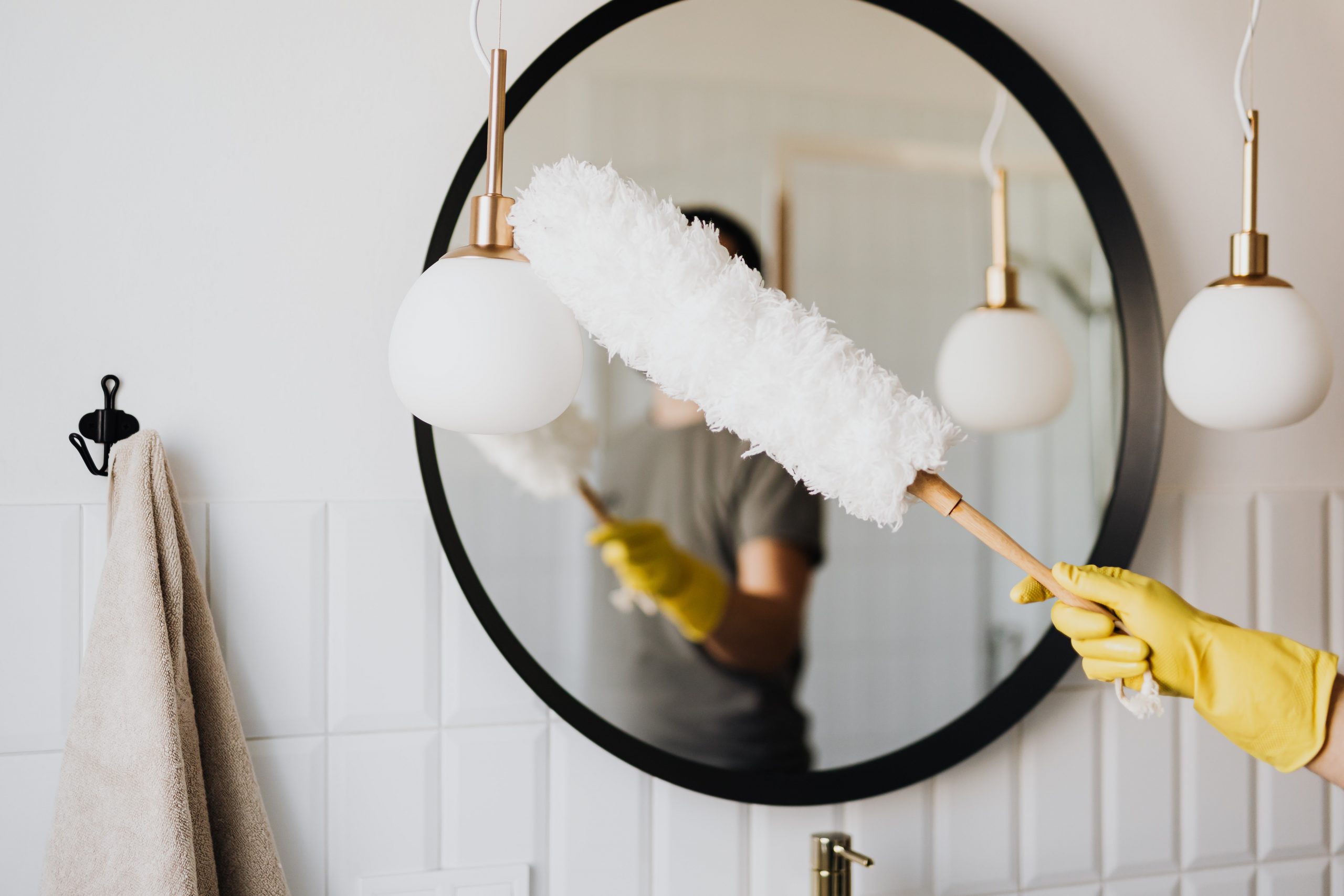Reasons to Call a Professional Cleaner – COVID-19

The value of regular cleaning and disinfecting the spaces we occupy has become more important than ever. Following the guidelines of the Center for Disease Control (CDC) and World Health Organization (WHO), it’s extremely important for the safety of you, your loved ones and colleagues that you take all precautions in preventing the spread of COVID-19.
Regular maintenance is key to reducing the risk of infection, and hiring a professional cleaning service can help you navigate creating a safe environment. While you may not need some cleaning each and every day, or even every week, consider the following scenarios when their expertise and resources can help keep you, your family and others safe.
COVID Recovery and Ongoing Cleaning
If someone in your household has tested positive for COVID-19, it is critical that they stay in a quarantined room or space. As they recover, hiring a professional service to help conduct a thorough cleaning of the entire household, including their space when healthy again, will ensure that you eliminate the possibility of infection for anyone else in your home.
Be clear with the cleaning company about the situation so they’re aware of the environment they’ll be in and can take extra personal precautions to keep themselves safe.
Water and Sewage Cleanup
Have you considered how your plumbing might also affect your health? When we think about the best cleaning and maintenance practices during a pandemic, we might only consider what’s on the surface. We may not realize that something like a sewage or plumbing incident can be just as dangerous as someone touching your countertops with unclean hands.
John Sooker, Chief Operating Officer and Executive Vice President at SERVPRO, “Water in sewer backups could have viruses, bacteria and other microbes that can cause illnesses, which is the last thing any homeowner or business wants under ‘normal’ circumstances, and certainly not during the current pandemic.”
If your sewage has backed up, don’t just call a plumber—call a cleaning company. Don’t let those bacteria and dangerous microbes live in your space.
Essential Worker Support
If you’re an essential worker clocking in extra hours and finding just enough time in the day for sleep, a professional cleaner may be a wise investment. Bacteria builds up even when we’re not in the home, and if you can’t maintain the regular cleaning required during COVID-19 while working full-time, hire a professional service. You’ll stay safe and enjoy extra peace-of-mind so you can use those extra non-work hours to relax and recharge.
In addition to standard cleaning needs, professional cleaners can also help identify areas in the home that need extra care. These are often places we forget to clean when completing our regular chores. For example, Prevention shares the germiest areas we touch every day:
Kitchen faucet
Garbage disposal
Dishtowel
Computer keyboard
Cell phone
Welcome mat
Vacuum cleaner
Soap dispensers
Work with a cleaning company to address these areas and create a plan for making your home a safe place to come home to.
Business Office, Retail and Living Space
If you own a business, you also need to consider the spaces where you and your employees work. While you can clean yourself following the guidelines, tips and information provided by the CDC, partnering with a professional cleaning service may ensure better results and keep you safe from potential infection.
When hiring a cleaning company for your business space, apartment building, or other property, consider looking for a business that’s well-versed in that type of space. This ensures that not only will the space be free of germs, but that the particular needs of that specific type of space are taken into consideration. For example, an office space has more areas to be cleaned than an apartment, and the right company will be prepared to do the job well.
After Guests Leave
Even if your guests were healthy, if you’ve had anyone stay anywhere in your home, it’s critical that you clean the space while they’re in the home and after they leave. While you can clean during their stay, it may be wise to bring in a cleaner once they’ve gone to ensure every area of your home is safe. With recent statistics saying 25-50 percent of people with COVID don’t know they have it, even “healthy” guests pose a danger.
Call a Professional Cleaner
Following the guidelines from the CDC and WHO is a great first step for keeping your home and business spaces clean. However, there are some situations when hiring a professional cleaning service is the safest option for you, your loved ones, and the other people living or coming and going to and from the area. Use these scenarios to determine whether you should bring in a cleaning crew to stay healthy during COVID.
A Beautiful Drink Station for Your Backyard Party

With an indoor party, you know that everyone is going to mingle in the kitchen no matter how hard you try to get them to spread out. Outdoors, you can be sure that everyone will huddle around the beverages. With that in mind, it’s time to deliberately make your outdoor drink station the focal point of the party.

From family reunions and holiday BBQ’s to outdoor weddings and graduation parties, the summer is ripe with celebration. A beautiful self-serve drink station means no one needs to stand around and pour drinks. Everyone gets to mingle and guests will have fun creating personalized concoctions.
You can go with just one theme and create a soda, lemonade or iced tea bar. Or, you can offer a little bit of everything. Adding some labels to dispensers or setting sings by the pitchers will allow guests to help themselves without seeking you out to ask which drink is which.
I love to help friends and family with life’s little celebrations. It’s easy to create a wow-factor beverage table. The really nice part is that you can get much of it ready ahead of time and simply carry it out into place on the day of the party. Creating a simple plan is key. I’ve put together the steps as well as some great ideas for your next summer event.
Be a Show Off

Since you are making the drink table front and center as a focal point, this is the time to show off. Start by deciding what you will use to hold everything. Folding tables or saw horses with tablecloths or even quilts are a good starting point. You can really glam things up by carrying out a decorative dresser or sideboard for the day.
The old adage that we eat with our eyes applies to beverages too. The fruit punch or lemonade might taste the same no matter what you put it in, but it will look amazing in a glass beverage dispenser, pitcher or punch bowl so the colors shine and the fruit is seen.

For visual appeal, choose glass bottles over canned beverages if you are offering individual drinks. Nestling the bottles in the ice makes everyone crave a cold drink. You can really have some fun with this idea by using interesting containers instead of hiding the drinks in a cooler. Dunk them in a galvanized bucket. Fill up a wheelbarrow, washtub or red wagon with ice and tuck in the bottles. For a baby shower, you could even use a baby bathtub. As long as the container is sturdy enough to hold the ice and drinks, you can let your imagination run wild.
Remember to set out a pitcher of water, as well as some sugar-free drinks like unsweetened iced tea, for guests who can’t consume sugar or just want an alternative option.
Keep Your Cool

Of course the key to an outdoor cold drink station is ice—and plenty of it! You’ll want to make sure to stock up on ice and have some on back up. A great tip for handling ice for a group is to get a freestanding ice maker. These countertop appliances are small and handy, yet they make pounds of ice. They can easily be left out for the party and then tucked in the cabinet until needed again.
Make It Fun

Continue the fun and grab colorful drink containers. For an outdoor event, you can get creative and use anything from glasses to mason jars to bright plastic tumblers. Even if you go the disposable cup route, you can still glam them up with tiny paper umbrellas or cute nametags.
Sugared rims are easy to do, but might not be something your guests want to attempt. You can easily pre-sugar the rims for a gorgeous presentation. Place a small account of water, lemon or lime juice in a saucer. Dip the rim of the glass in the liquid, then dip the wet rim into a saucer of sugar. Use tinted sugar for a pretty effect.

Garnishing the glasses is where your guests get a chance to have fun and really personalize their drink. Set out bowls of cleaned and sliced garnishes. It’s easy to mix and match a variety of garnishes with ice tea, lemonade, punch and sodas for unique beverages— and the garnishes makes them look so pretty.
Some of my favorites include bowls of fresh blueberries and raspberries, sliced strawberries, skinny circles of cucumber, wedges of lemon and lime and thin pieces of melon. Sprigs of fresh mint and rosemary are best kept in a tiny bit of water so they stay fresh. Colorful straws, skewers and drink stirs give more mix and match options.
It’s really simple to pull all these components together so your drink station is not just a pretty focal point, but is also entertaining and delicious.
Lea Schneider is an organizational expert who knows that good planning often translates into good times. Lea writes her advice on backyard parties and other outdoor activities for The Home Depot. To review a wide selection of ice chests and freezers that may fit the bill for your next warm weather get-together, you can visit the Home Depot website.
5 Home Staging Secrets from the Pros

If you are selling your home, these home staging secrets from Chicago-area pros could help you get top dollar.
1. Know Your Buyer
While you want to appeal to the broadest group of potential buyers, you also need to have a good idea who your most likely buyer is, and stage your home accordingly.
“If your home has four bedrooms, is located near an elementary school, and has a park down the street, chances are your buyers will be a young family. So make sure you stage at least one of the bedrooms as a young child’s room,” says Julea Joseph of Reinventing Space in Palos Park.
2. Light it up
If there’s one thing our pros seem to agree on, it’s that today’s buyers want a home that is light, bright, and airy.
“The first thing I do is open the curtains, raise the blinds, and turn on all the lights,” says Audrey Gourguechon of Staging North Shore in Northfield.
“We make sure every light bulb is working and that they are all the same color: ideally a warmer glow versus a cooler, bluer light,” says Shani Abrams of Shani and Jane re-Design in Skokie
“Mirrors are great for staging,” says Anne Fitzpatrick, a designer and stager based in Glencoe. “They read visually as another window, reflecting the light and making the space feel twice the size.”
3. Highlight Features and Avoid Distractions
“We remind our clients that people are buying the house, not the stuff in it. The problem with mementos, photographs, or collections is that they distract the buyer from seeing the architectural features of your house,” says Gourguechon. “We don’t want them wondering who lives there. We want them to imagine themselves living there.”
Remove wall-to-wall carpeting that’s covering hardwood floors. “Otherwise, you’re wasting one of your home’s key selling points. You’re leaving money on the table,” explains Joseph.
4. Maximize the Flow
Creating a smooth flow through the house is key to making people feel comfortable and not cramped. Flow is important for physical movement through the space as well as the way the eye takes in the room.
Continuity in flooring will open the space up and improve the flow, as will using the same wall colors.
Wallpaper is a big no-no. Not only is it unappealing to today’s buyers, it also chops up the space visually. Get rid of it and paint the walls the same neutral tones.
Too much furniture interrupts the flow in a room and blocks important features like the fireplace or the windows. Streamline your furniture and arrange the pieces to create inviting conversation areas.
5. Update Selectively
The last thing a home seller wants to do is spend a ton of money on a house they’re not going to be living in. But there are some updates that make a big impact without costing a lot.
A can of paint is the best investment you can make. Painting the walls a warm neutral will make everything seem fresher and more current.
“You can breathe new life into an old kitchen by painting oak cabinets a soft white,” says Gourguechon.
“Replacing old cabinet hardware in the kitchen and baths or changing out old light fixtures is a great way to make a home feel up to date,” says Joseph.
“New bedding is another inexpensive way to make a big impact. Buy a fresh new duvet and pillow shams that you can put on your bed for photos or showings,” says Abrams.
Try these home staging secrets when putting your house up for sale!
How to Avoid the Top 5 Home Seller Mistakes

When you are selling your home, it can be easy to be in a vacuum. You have a certain idea of what the market should pay for your home and what may or may not be an issue. After all, you are king of your castle, right? Your home has x, y and z . The location can’t be beat. It’s just around the corner from (insert fabulous restaurant, park, coffee shop, school, etc. here).
However, when buyers and agents are coming through your home, it can be where distorted perception meets reality. Here are the top mistakes sellers make and how to avoid them.
1. Overpricing Your Home
If your home is overpriced, two things won’t happen: showings or offers. The price is what sets the tone for showings. It is the nonverbal message that either invites or discourages activity. If it is too high, buyers that can afford it may be interested in something else, as they can go higher in price range, and the audience for whom it was intended price-wise are usually shut out. To avoid frustration over offers much lower than your set price, have an open discussion with your real estate agent to set the right price for your home.
2. Making Showings Difficult
Restricted showing times, no lockbox or having to be present for all showings can impact the ability of showing traffic through your home. If there are umpteen instructions or restrictions, agents and their buyers will simply move on to those properties with less rules. Work with your real estate agent to find a way to make showings convenient for both you as the seller as well as potential buyers.
3. Not Countering an Offer
While everyone would love to get the most for their home, a seller also needs to keep a realistic balance. It is too easy to get hung up on the starting number in an offer when the focus should be on what the end result is. The opening offer is simply that –a starting point. It gets a conversation going and results in hopefully a happy medium that is amenable to the buyer and seller. Not countering an offer is like having a one way conversation. It won’t work. How can you move to sold if you can’t have a dialogue of back and forth? It doesn’t mean that the buyers aren’t serious, they are simply being conservative in their first offer to get a feel for how the negotiation is going to go. It doesn’t mean that is the most they are willing to pay unless the offer was positioned that way. Failure to counter sends a discouraging signal to the buyer that can create an uncomfortable situation, perceived or real. Buyers want to do business with sellers who are eager to do business with them. You don’t have to give away the store to do so, but certainly responding with a number in good faith is a step in the right direction.
4. Property Condition Denial
Would you as a buyer pay top dollar for a home with original systems approaching the end of their life? In today’s real estate climate, buyers, lenders, appraisers and inspectors are more scrutinous than ever. It is not only the buyer, but the lender, appraiser and the buyer’s insurance company that could be making the call on a home’s condition. Before you sell, be realistic about the condition of your home. Unless the home is deeply discounted below market value, which realistically means it would be far too low price-wise that you would agree to accept, the buyer will care about it and if they don’t, their home inspector certainly will!
5. Selective Memory
Sellers often fear that if they disclose too much or provide too many details, that it could affect their ability to sell for top dollar; however, failure to disclose could open you up to liability after the sale. Leaving questions blank, or not being clear on the age of certain things only creates more red flags and concern for a potential buyer. If you answer the questions honestly and fully disclose any known issues or repairs that were made (with receipts to document and provide a history) it will eliminate buyer fear and doubt.
5 Things You Need to Know About Selling a Condo

Thinking of selling your condo? Whether you live in the condo or own it as an investment property, if you’re ready to sell your home, it’s time to talk to a qualified real estate agent in your area. By evaluating several criteria, including regional markets, time of year, features of your condo unit, as well as your specific needs as the seller, he or she can create a customized marketing plan for your condo. Here are five important topics to discuss with your real estate agent if you want to sell your home:
1. Best Time of Year to Sell Your Condo
The specifics of your area do more to determine the best time to put your home on the market than whether you’re selling a condo or a house. While the conventional wisdom is that spring is the best time for selling a home, this belief simply doesn’t ring true in every locale. In recent years the historic patterns have eased, and in some cases, totally disappeared. Still, different parts of the country have periods when sellers can be more aggressive with their pricing. And your real estate agent may suggest a distinct timing strategy for condominium sales, especially if your condo is in a resort destination.
2. Open House Strategy and How to De-Clutter
A condo that shows well will sell faster and bring a higher price. Small cosmetic touch-ups can make a big difference. Buyers often suspect that more serious problems may exist if they notice the need for minor repairs. If you want to sell your home, it’s important to make sure your condo is clean, tidy and free of personal clutter. Clear sinks and counters of dishes and toiletries. Neatly stack office supplies and organize storage areas. Replace dim light bulbs and clean windows. Even though your garden area may be commonly owned, do your best to create curb appeal by cleaning front steps and porches, and clearing lawns of toys or equipment.
3. Features to Accentuate
One of the best features to accentuate when selling a condo is the lifestyle of ease that comes with condominium ownership. Many buyers are looking for the hassle-free living experience that they can’t find with a single-family detached house. Another important attribute of any condo is the amenities of the association, which can include a hot tub, fitness center, owner’s lounge, covered parking and even concierge services. If you’re considering selling your condo, take the time to walk through it methodically with your real estate agent. Together you can point out which features of the actual condo unit should be accentuated. Does your unit have a wonderful view? Perhaps the location of your condominium is unique and desirable. Your real estate agent can help accentuate these features in sales and marketing materials.
4. Desired Price and Bottom Line Price
When setting the home price for your condo, it’s important to identify your desired price and your bottom line price. By assessing recent condo sale and listing statistics in your area, your real estate agent and a licensed appraiser can estimate your house value and recommend an appropriate target price range. Working with your agent, you can set an initial asking price, as well the absolute lowest home price you would comfortably accept. One advantage of selling a condo is that by assessing the prices of other units in your association that have recently sold or are currently listed, your real estate agent and the appraiser can determine a very accurate house value.
5. Disclosures
When selling your condo, you may be obligated to disclose problems that could affect the property’s value or desirability, as well as to disclose HOA minutes and costs of common insurance and utilities. In most states, it is illegal to fraudulently conceal major physical defects in your property, such as a water heater that leaks severely. And many states now require sellers to take a proactive role by making written disclosures on the condition of the condo unit. Ask Cori Hamilton for the particular laws of your state.
Fairy Terns – A Special Sighting!

You wouldn’t believe what I found outside one of my beautiful listings at the foot of Diamond Head: a nest of Fairy Terns! I was so tickled to see nature in action, and I decided I didn’t know enough about these fascinating birds so I did some research. I have distilled some of my newfound knowledge below so that you will finish the day wiser and more aware of these magnificent little creatures.

Ancient Hawaiian seafarers used the Hawaiian fairy tern, or Manu-o-ku, as an indication that land was close: the bird generally flies out to sea in the morning and then back to land in the evening, so its presence suggested that land was not far off. As nightfall came, the navigators followed the birds until land was sighted.
Today, the Hawaiian fairy tern is found primarily in the Northwest Hawaiian Islands. Amazingly, Oahu is the only main island on which fairy terns reside – and in fact, they only nest in Leeward Oahu, from Niu Valley to Sand Island. Incidentally, this makes Honolulu the only city in the world where the Hawaiian Manu-o-ku is found!
Hawaiian fairy terns haven’t always been found in Honolulu, though. In fact, the first nesting pair wasn’t discovered on Oahu (on Koko Head, specifically) until 1961, and the fairy tern population only numbered about 700 birds in 2003. Today, though, that number has quadrupled – Oahu is now home to about 2,800 nesting birds, where they can be seen roosting in large trees in parks and along the street.
The fairy tern is a medium-sized, all-white seabird that nests in large trees in or near the shore, where they will have easy access to the ocean. Unlike its South Pacific fairy tern cousins in Australia and New Zealand, the Hawaiian fairy tern is completely white, except for a black ring on it eye, a black beak, and pale blue legs and feet. Their tail is subtly forked, and their wingspan is nearly 3 feet long and narrow, which allows them to expend little energy while flying long distances over the ocean. Male and female terns look identical, and their plumage stays the same throughout the year. Fairy tern chicks are usually a bit more mottled in color, with brown or gray feathers mixed into their plumage. By the time they reach breeding age, though, the tern’s plumage has turned completely white.

Manu-o-ku forage in inshore and offshore waters, and consist on a diet primarily of fish and squid. They are opportunistic feeders, and wait on other predators to drive small fish to the surface where they either grab the fish from below the surface or from midair as the fish jumps to escape another predator. When the fairy tern nests, it will bring fish back to its young – you can sometimes see the bird carrying fish in its beak!
One might think that an urban-dwelling bird would struggle to thrive in a big city, where tree trimming and urban development might harm their habitat. But that’s exactly why they thrive, and incidentally what makes these birds so fascinating: when a tree branch is cut a scar or depression is often formed, in which the tern will lay its egg – without a nest! And when the chick is born, it learns very quickly to hold on tight with its teeny little talons so as to avoid being blown off the branch by a gust of wind.
As the chick grows, both the male and female tern participate in feeding and raising the chick until it departs the nest – or rather, the branch – on which it hatched. Often, breeding pairs of terns will return to the same nesting site multiple times to hatch new tern chicks.
In 2007, Mayor Mufi Hanneman designated the Manu-o-ku as the official bird of the City and County of Honolulu. Although the bird is still considered a threatened species, it is certainly making a resurgence, and thanks to many conservation efforts the numbers of fairy tern nesting sites is growing steadily throughout Honolulu. These little creatures are so beautiful and elegant, and I was so blessed to watch them in their natural habitat. If you see one flying around, consider yourself lucky: the Manu-o-ku is one of the only native Hawaiian birds that can be seen in the city of Honolulu!
*Image by 12019 on Pixabay

 Facebook
Facebook
 X
X
 Pinterest
Pinterest
 Copy Link
Copy Link






